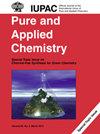丙烯酸正丁酯和 N,N-二甲基丙烯酰胺的随机交联两亲共聚物网络:合成与表征
IF 2
4区 化学
Q3 CHEMISTRY, MULTIDISCIPLINARY
引用次数: 0
摘要
通过疏水性丙烯酸正丁酯(BuA)和亲水性 N,N-二甲基丙烯酰胺(DMAAm)的自由基交联共聚,制备了五种随机交联的两亲共聚物网络(ACPN)、在有少量(占 BuA 和 DMAAm 单体总和的 5 摩尔%)疏水性 1,6-hexanediol diacrylate (HexDA) 交联剂存在的情况下,由 4,4ʹ-偶氮双(4-氰基戊酸)在 1,4- 二氧六环中以 10% w/v 的单体总浓度引发。五种 ACPN 的 BuA 含量各不相同,分别为 10、30、50、70 和 90 摩尔%。两种均聚物网络(BuA 和 DMAAm)也是采用相同的聚合方法制备的。因此,本研究共涉及七种聚合物网络,形成了一个同源系列,BuA 含量范围为 0 至 100 摩尔%。这些网络在四氢呋喃(THF)和水中的溶胀度、在水中的机械性能以及与人体皮肤的粘附性都得到了表征。网络在四氢呋喃中的溶胀度(DS)高于在水中的溶胀度,这是因为四氢呋喃是一种非选择性溶剂,而水对亲水性 DMAAm 单元具有选择性。四氢呋喃中的 DS 随网络中极性较弱的 BuA 单元含量的增加而增加,而水中的 DS 则相反,随疏水 BuA 单元含量的增加而减少,从 11(0 摩尔 BuA)降至 1.1(100 摩尔 BuA)。在含 50 摩尔 BuA 的水凝胶中观察到了最大弹性模量,这反映了软聚合物(polyBuA)含量和水凝胶含水量中聚合物成分的相反作用。相反,断裂拉伸应变随着水凝胶中 BuA 含量的增加而单调增加,BuA 含量为 90 摩尔的水凝胶的断裂拉伸应变达到了惊人的 ∼ 900 %。最后,研究了 ACPNs 在干燥和水合状态下与人体皮肤的粘附性。水合样品在皮肤上的附着力强于干燥样品。含 30 摩尔 BuA 的水合 ACPN 对皮肤的附着力最强,这归功于极性 DMAAm 单元含量相当高(70 摩尔)和水溶液 DS 值相当低(∼2.5)的最佳组合,低 DS 值仅导致参与与皮肤极性相互作用的 DMAAm 单元的少量稀释。本研究表明,即使在这种合成简单的 ACPN 体系中,ACPN 成分对某种性质的多重影响,在某些情况下是对立的,而在另一些情况下则是相互配合的,从而导致了相当复杂的行为。特别是,随着 BuA 含量的增加,某些特性(水合 ACPN 的弹性模量、断裂应力和断裂能,以及水合 ACPN 在皮肤上的附着力)显示出最大值,而另一些特性(水合 ACPN 的断裂应变,以及干燥 ACPN 在皮肤上的附着力)则显示出单调增加。因此,特定应用的最佳 ACPN 在很大程度上取决于最适合特定应用的特性,例如,含 30、50 和 90 摩尔 BuA 的 ACPN 分别具有最强的皮肤湿粘附性、最硬的水凝胶反应以及最高的水凝胶延展性和韧性。本文章由计算机程序翻译,如有差异,请以英文原文为准。
Randomly cross-linked amphiphilic copolymer networks of n-butyl acrylate and N,N-dimethylacrylamide: synthesis and characterization
Five randomly cross-linked amphiphilic copolymer networks (ACPN) were prepared via the free radical cross-linking copolymerization of the hydrophobic n -butyl acrylate (BuA) and the hydrophilic N ,N -dimethylacrylamide (DMAAm), in the presence of a small amount (5 mol% with respect to the sum of BuA plus DMAAm monomers) of the hydrophobic 1,6-hexanediol diacrylate (HexDA) cross-linker, initiated by 4,4ʹ-azobis(4-cyanovaleric acid) in 1,4-dioxane at a 10 % w/v total monomer concentration. The five ACPNs differed in their BuA content, fixed at 10, 30, 50, 70 and 90 mol%. The two homopolymer networks, BuA and DMAAm, were also prepared using the same polymerization method. Thus, this study involved a total of seven polymer networks, forming a homologous series with BuA contents ranging from 0 to 100 mol%. These networks were characterized in terms of their degrees of swelling in tetrahydrofuran (THF) and water, their mechanical properties in water, and their adhesion to human skin. The degrees of swelling (DS) of the networks in THF were higher than those in water because THF is a non-selective solvent, whereas water is selective for the hydrophilic DMAAm units. The DSs in THF increased with the network content in the less polar BuA units, while the opposite was true for the DSs in water which decreased with the content in the hydrophobic BuA units from 11 (0 mol% BuA) down to 1.1 (100 mol% BuA). A maximum in the elastic modulus was observed for the hydrogel with 50 mol% BuA, reflecting the opposing effects of polymer composition in soft polymer (polyBuA) content and hydrogel water content. In contrast, the tensile strain at break increased monotonically with the hydrogel BuA content, reaching a remarkable ∼900 % for the hydrogel with 90 mol% BuA. Finally, the adhesion of the ACPNs, both in their dried and hydrated states, onto human skin was explored. The adhesion of the hydrated samples onto skin was stronger than that of the dried ones. The hydrated ACPN with 30 mol% BuA exhibited the strongest adhesion onto skin, attributable to the best combination of a rather high content in polar DMAAm units (70 mol%), and a rather low aqueous DS (∼2.5), with the low DS value causing only a small dilution in the DMAAm units participating in the polar interactions with skin. The present work demonstrates that, even in this synthetically simple ACPN system, the multiple effects of ACPN composition on a certain property, in some cases opposing and in some other cooperating, lead to a rather complicated behavior. In particular, as the BuA content increases, some properties display maxima (elastic modulus, stress at break and fracture energy of hydrated ACPNs, and adhesion of hydrated ACPNs onto skin) while some other properties exhibit monotonic increases (strain at break of hydrated ACPNs, and adhesion of dried ACPNs onto skin). Thus, the optimal ACPN for a particular application will highly depend on the property best-serving the particular application, e.g. , the ACPNs with 30, 50 and 90 mol% BuA for strongest wet adhesion to skin, stiffest hydrogel response, and highest hydrogel extensibility and toughness, respectively.
求助全文
通过发布文献求助,成功后即可免费获取论文全文。
去求助
来源期刊

Pure and Applied Chemistry
化学-化学综合
CiteScore
4.00
自引率
0.00%
发文量
60
审稿时长
3-8 weeks
期刊介绍:
Pure and Applied Chemistry is the official monthly Journal of IUPAC, with responsibility for publishing works arising from those international scientific events and projects that are sponsored and undertaken by the Union. The policy is to publish highly topical and credible works at the forefront of all aspects of pure and applied chemistry, and the attendant goal is to promote widespread acceptance of the Journal as an authoritative and indispensable holding in academic and institutional libraries.
 求助内容:
求助内容: 应助结果提醒方式:
应助结果提醒方式:


